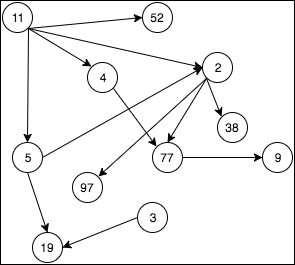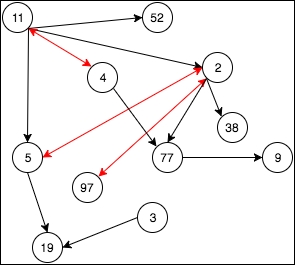Visual graph concepts
It is sometimes easier to grasp the concept of graph data structures using visual representations of some collections. Consider the following diagram:

This is a basic graph consisting of eleven nodes and twelve edges. Sets N and E can be described as follows:
N = {2, 3, 4, 5, 9, 11, 19, 38, 52, 77, 97}
E = {2:38, 2:77, 2:97, 3:19, 4:77, 5:2, 5:19, 11:2, 11:4, 11:5, 11:52, 77:9}
Note that, in this example, there are only unidirectional edges between nodes. This is perfectly acceptable, but graphs are much more powerful when bidirectional nodes are permitted. Consider the following example:

This is the same graph we saw earlier, but set E now contains several new reciprocal edges between existing nodes. Sets N and E can now be described as follows:
N = {2, 3, 4, 5, 9, 11, 19, 38, 52, 77, 97}
E = {2:5, 2:38, 2:77, 2:97, 3:19, 4:11, 4:77, 5:2, 5:19, 11:2, 11:4, 11:5, 11:52, 77:9, 97:2}
Finally, edges between nodes can also be defined with a particular value. Consider the following...






























































